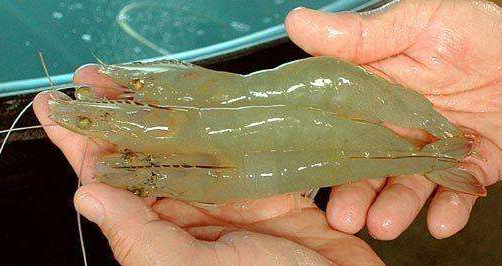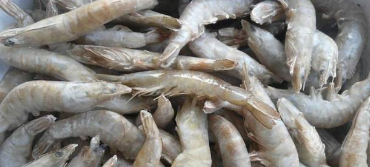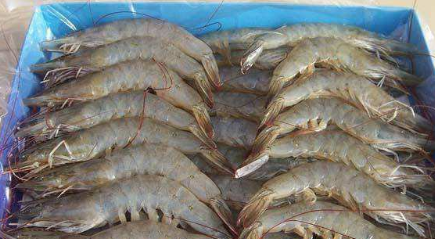P. vannamei is one of the important domestic and export aquatic products in China. Since the promotion of large-scale farming in Hangzhou in 2003, the processing power of frozen shrimp has been growing. At present, the main frozen shrimp varieties of P. vannamei in this region are: frozen (raw) single frozen prawns, frozen (cooked) single frozen prawns; (raw) frozen prawns and shrimps and other products, this series of products are mainly sold in China. There are also some prawns, breaded shrimps and cooked shrimps in the exported processed products, but this part accounts for a smaller processing ratio. Through years of exploration and practice, we have summarized the processing technology of some of the above products.
 First, take the lead (raw) block frozen processing technology
First, take the lead (raw) block frozen processing technology
1. Process description:
Raw shrimp purchase a raw shrimp cleaning a specification grade one ice water soak one water control one weighing one swing disk one feed one discharge off plate ice plating one inside and outside packaging one refrigerated
2, process discussion
(1) Raw material shrimp purchase: Raw materials entering the factory are required to be inspected for quality and sanitation. After passing the inspection, they can be allowed to enter the processing plant area; for export processing enterprises, all raw materials should come from the export record breeding base. However, the more important point is that before the processing season comes, the factory should send some inspection personnel to some farms to carry out random inspections on some indicators such as drug residues and heavy metal residues to prevent bad products from circulating to the market.
(2) Raw material shrimp cleaning: After the raw material shrimp enters the acquisition conveyor belt, some humans are arranged to clean up and select the raw shrimps for impurities and spoiled shrimps, and then rinse with clean water that meets the hygienic standard; if conditions permit, finally use the steam bubbles. Rinse the assembly line, which not only saves labor, but also deeply cleans the sludge and other debris in the head of the shrimp.
(3) Specification grading: Prior to the absence of the mechanical automatic classifier, the previous prawn processing plants were manually graded; however, as the cost of domestic laborers increased year by year, most manufacturers currently use shrimp automatic classifiers to South America. White shrimp is graded in different sizes. The main precautions in automatic grading are to prevent the prawn level, that is, to prevent uneven grading of the prawn after grading; at present, most manufacturers use part of the labor force at the discharge of the classifier to reduce such phenomena. occur. Usually, the grading amount of one machine per hour is about 1 ton, but the grading amount of small specifications is correspondingly reduced. In the grading process, it should also be noted that part of the ice should be added to the raw material barrel of the classifier from time to time to maintain the quality of the shrimp when the extension is maintained.

(4) Immersion in ice water: Under normal circumstances, because different sizes of shrimps from the classifier cannot be processed in the quick-freezer at the same time, the finished shrimp must have a buffered temporary storage area after classification. If the workshop temperature can be controlled below 10~C, ordinary food-grade plastic drums can be used; the capacity of the barrel is about 600-1000 liters. However, if the temperature of the workshop is difficult to control, the insulated barrel should be used to temporarily store the finished shrimp. However, no matter which way the shrimp is temporarily stored, the temperature of the ice water in the barrel should be controlled as much as possible below 4-6 °C. If the temperature of the soaking water is too high, the speed of deterioration of the shrimp will be significantly accelerated. Usually, the soaking time should be controlled within 4 hours.
(5) Water control and weighing: Water control is a processing program established to reduce the error of the finished product after thawing as much as possible. Common food grade baskets are usually used as water control tools, and the weight of each basket of shrimp is controlled between 15 and 30 kg. The water control standard is usually: the prawn in the basket is drained to the flow to be used for weighing. Weighing should use an electronic scale with an error suitable for the corresponding volume of the iron plate or plastic plate. At present, the weight of each net shrimp in the domestic market is 0.6 to 2kg, so the electronic said that the maximum weight is about 5kg. The maximum error of each disc when weighing shrimps should be controlled within 10-20g.
(6) Wobble plate: The tools currently in place in China are mainly iron plates and plastic plates. It is better from the refrigeration effect, but if it is not made of stainless steel, it will be easy to rust. Plastic discs have the advantages of low cost and easy transportation, but the disadvantage is that the cooling effect is relatively poor compared to the iron disc. When the plate is placed, most of the outer block freezes require the top layer to be arranged in order. However, there is less demand for the domestically sold frozen prawn. The domestically sold frozen shrimp in the processing plants in Guangdong and Guangxi also require the top shrimp to be arranged in order. At present, more frozen products are placed in front of the plate, and a food grade plastic sheet is required at the bottom of the plate to facilitate the later unloading and packaging.
(7) Feeding: The feed is divided into a variety of types due to the variety of refrigeration equipment. Currently, two feed methods are mainly used. One is the more traditional ones, which are frozen freezer; the other is a running water type freezing device, such as a spiral freezer or a tunnel freezer. The former is more labor-intensive, and the quick freezing time is long, and the product appearance is poor. However, due to the investment, the production volume can be large or small, and the power consumption is smaller than other quick-freezing equipment. Therefore, there are still some capacity reserves in China, but The post trend will be replaced by a flow-through refrigeration unit. The flow-type freezing equipment has the advantages of small floor space, good labor and speed, etc., but the investment and power consumption are relatively large. The quick-freezing library feed mainly relies on manual entry into the quick-freezing warehouse to place the prawns placed on the trays on the corresponding drain pipes. The running water type only needs to be placed on the feed port by the individual personnel.
(8) Unloading plated ice-coating: When the central freezing temperature of the shrimp is less than minus 18 °C, the material can be discharged; when discharging, the quick-freezing library needs to manually enter the quick-freezing warehouse to take out the cold prawns; but the flow-type freezing Simply pick up at the delivery port. After the discharge, the frozen prawns and the plate are placed in ice water for about 5 seconds and then drained and drained. The main purpose of the prawn glaze is to prevent the frozen prawn from being placed in the cold storage for a long time. One step. Under normal circumstances, the water temperature of the glaze should be below 4 °C, otherwise it will lead to softening and deformation of the frozen product. At present, some manufacturers use the watering method to coat the ice and remove the plate. This method saves manpower compared with the former, but it also exists The problem of uneven water. The water of the glazed water, if possible, treat the purified water treated with the equipment as much as possible to further enhance the appearance and surface transparency of the frozen prawn.
(9) Packing into the warehouse: Put the product after the unloading into the plastic bag, put the finished product into the carton or foam box according to the specifications in the environment below 10 °C, and seal it with the dry tape. Immediately after packing, the carton is transferred to a (20 ± 1 ° C) freezer and stored as required.
Second, take the lead (raw) single frozen processing technology
1. Brief description of the process: raw shrimp purchase a raw material shrimp cleaning a specification grade one ice water soak one water control one feed one discharge one iced coat one second frozen one weighing one inner and outer packaging one cold storage
2. Process Discussion The difference between single frozen shrimp and frozen shrimp is that after quick freezing into finished products, frozen shrimp and shrimp are connected together, and they can only be separated after thawing. After the frozen shrimp is frozen into finished products, the shrimp bodies are not connected. This section breaks down the process flow from the different steps of the above frozen shrimp.
(1) Feeding: The frozen shrimp needs to be placed after the plate is placed, and the single frozen shrimp can be fed only after the water is controlled. Also, single frozen shrimp can only be processed with a running water type freezing device. The semi-finished product after water control is directly and evenly sprinkled on the mesh belt of the spiral quick-freezer for quick freezing; note that only the shrimp are separated and not allowed to overlap.
(2) Secondary quick freezing: After the first quick freezing of the screw machine, the center temperature of the shrimp body reaches minus 18 °C, and the semi-finished product enters the glazing pool. The time is controlled within half a minute, but the specific time needs to be glazed with the shrimp target. The combination of the amount of clothing; the longer the time, the greater the amount of glaze, but not too long, otherwise it will lead to the thawing of the plated jelly. After the ice-coating, the semi-finished prawns need to enter the secondary quick-freezing machine to freeze and dry the surface water of the shrimp body, otherwise the product will be stuck and anti-frost. The cooling temperature in the secondary freezer should be controlled at around 25 °C. Too low will cause the surface of the shrimp body to crack, and overheating will cause the center temperature of the shrimp body to be too high.
(3) Discharge and weighing: The shrimp after the second freezing should be packaged in the workshop below 10~C at room temperature, otherwise it will be suitable to cause the melting of the surface ice and the adhesion of the shrimp. Single frozen shrimps are usually packed in a large plastic bag and placed in a carton or foam box.
Third, lead (cooked) single frozen processing technology
1. Brief description of the process: raw shrimp purchase a raw material shrimp clean one steaming one cooling one specification grade one ice water soak one water control one feed one discharge one iced coat one time two freeze one weighing one inner and outer packaging one refrigeration.
2, process discussion
The difference between the head (cooked) single-freezing process and the (raw) single-frozen is mainly the two steps of cooking the prawns with a digester and cooling the cooked prawns with ice water after the raw shrimps are cleaned. This section breaks down the process flow and the different steps of the above-mentioned single-frozen single-frozen.
(1) Cooking: At present, the energy of the cooking machine mainly has two modes of electric power and boiler. Relatively speaking, the cooking method of the boiler is relatively stable and common. The cooking carrier also has two types of hot water and steam, which are easy to maintain the nutrients in the shrimp body. The temperature is controlled in the range of 98-100~C during cooking; the cooking time is controlled in about 2 minutes. After cooking, it is sent to the normal temperature water spray station, and then enters the normal temperature cooling pool. If the temperature and time are deviated during cooking, it should be adjusted and tested in time before re-cooking.
(2) Cooling: After the semi-finished product after cooking is cooled frequently, it can be immersed in a 4~C ice water bucket to quickly lower the temperature of the shrimp body to below 10 °C, to be classified.
(3) About cooked shrimp: At present, the quality requirements of cooked shrimp in domestic and foreign markets are high, and the quality of blackheads cannot occur. Therefore, in the cooked shrimp process, the most critical is the acquisition. At present, most manufacturers in Hangzhou use live water to purchase prawns, which can effectively reduce the incidence of blackheads and U-turns.
 Fourth, the conclusion
Fourth, the conclusion
Shrimp processing is an art, not only requires good product quality, good taste, but also requires aesthetic appearance. At present, shrimp processed products in our region are mainly facing competition from manufacturers in Guangdong and Guangxi, and foreign countries are facing competition from shrimp farmers in Thailand, Vietnam, Indonesia and India for global competition. However, the Hangzhou area is rich in natural resources and supported by the public sector. The shrimp industry in our region will continue to develop and serve the country and the world market for a long time.
With the vision of "building a global professional drip mold supplier" and the mission of "providing solutions for efficient and innovative production of global water-saving irrigation enterprises",our company take "scientific and technological innovation to scale new heights; Keep improving, the pursuit of excellence; Honesty and trustworthiness,win-win cooperation "for the values of our enterprise. We try our best to make a positive contribution for the construction of water - saving and resource-saving society.
Flat Emitter,Cylindrical Emitter,Dripper Mold,Backyard Drip Irrigation System
Shandong Spring Rain Water Saving Irrigation Equipment Co.,Ltd. , https://www.drippermould.com